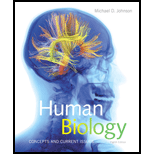
Human Biology: Concepts and Current Issues (8th Edition)
8th Edition
ISBN: 9780134042435
Author: Michael D. Johnson
Publisher: PEARSON
expand_more
expand_more
format_list_bulleted
Question
Chapter 17, Problem 1AWK
Summary Introduction
To review:
Effects of pairing C with T during
Introduction:
Deoxyribonucleic acid (DNA) is actually made up of four nitrogenous bases, i.e., adenine, thymine, guanine, and cytosine (A, T, G, and C). One nitrogenous base of one DNA binds with another nitrogenous base present on another DNA, thus producing double helix DNA. Normally G binds with C and A binds with T.
Expert Solution & Answer
Want to see the full answer?
Check out a sample textbook solution
Students have asked these similar questions
What is the structure and function of Eukaryotic cells, including their organelles? How are Eukaryotic cells different than Prokaryotic cells, in terms of evolution which form of the cell might have came first? How do Eukaryotic cells become malignant (cancerous)?
What are the roles of DNA and proteins inside of the cell? What are the building blocks or molecular components of the DNA and proteins? How are proteins produced within the cell? What connection is there between DNA, proteins, and the cell cycle? What is the relationship between DNA, proteins, and Cancer?
Why cells go through various types of cell division and how eukaryotic cells control cell growth through the cell cycle control system?
Chapter 17 Solutions
Human Biology: Concepts and Current Issues (8th Edition)
Ch. 17 - How do you feel about the creation and then...Ch. 17 - How far should we go–to what lengths and at what...Ch. 17 - Describe how DNA is replicated before cell...Ch. 17 -
2. Compare and contrast the processes of...Ch. 17 - Explain what mutations are and the role of DNA...Ch. 17 - Name the four phases of mitosis and describe...Ch. 17 -
5. Explain why only one large egg is formed...Ch. 17 - Describe what is meant by selective gene...Ch. 17 - Explain how factors present in the environment can...Ch. 17 - Describe how ribosomes contribute to the formation...
Ch. 17 - Prob. 9CRCh. 17 - Prob. 10CRCh. 17 - What would be the outcome if a cell completed...Ch. 17 - Prob. 2TYCh. 17 - Prob. 3TYCh. 17 - Prob. 4TYCh. 17 - Which of the following are listed in order from...Ch. 17 - Prob. 6TYCh. 17 - Which is likely to be the shortest chain of...Ch. 17 - How many different amino acids could be encoded if...Ch. 17 - Prob. 9TYCh. 17 - Why do cells within an organism differentiate,...Ch. 17 - Which method of cloning is most similar to the way...Ch. 17 - Prob. 12TYCh. 17 - Prob. 13TYCh. 17 - Prob. 14TYCh. 17 -
15. How does the production of sperm differ from...Ch. 17 - Prob. 1AWKCh. 17 - Prob. 2AWKCh. 17 - Prob. 3AWKCh. 17 - Prob. 4AWKCh. 17 - Mitochondria contain their own DNA that is...Ch. 17 - Bacteria can reproduce by simple cell division....
Knowledge Booster
Learn more about
Need a deep-dive on the concept behind this application? Look no further. Learn more about this topic, biology and related others by exploring similar questions and additional content below.Similar questions
- In one paragraph show how atoms and they're structure are related to the structure of dna and proteins. Talk about what atoms are. what they're made of, why chemical bonding is important to DNA?arrow_forwardWhat are the structure and properties of atoms and chemical bonds (especially how they relate to DNA and proteins).arrow_forwardThe Sentinel Cell: Nature’s Answer to Cancer?arrow_forward
- Molecular Biology Question You are working to characterize a novel protein in mice. Analysis shows that high levels of the primary transcript that codes for this protein are found in tissue from the brain, muscle, liver, and pancreas. However, an antibody that recognizes the C-terminal portion of the protein indicates that the protein is present in brain, muscle, and liver, but not in the pancreas. What is the most likely explanation for this result?arrow_forwardMolecular Biology Explain/discuss how “slow stop” and “quick/fast stop” mutants wereused to identify different protein involved in DNA replication in E. coli.arrow_forwardMolecular Biology Question A gene that codes for a protein was removed from a eukaryotic cell and inserted into a prokaryotic cell. Although the gene was successfully transcribed and translated, it produced a different protein than it produced in the eukaryotic cell. What is the most likely explanation?arrow_forward
- Molecular Biology LIST three characteristics of origins of replicationarrow_forwardMolecular Biology Question Please help. Thank you For E coli DNA polymerase III, give the structure and function of the b-clamp sub-complex. Describe how the structure of this sub-complex is important for it’s function.arrow_forwardMolecular Biology LIST three characteristics of DNA Polymerasesarrow_forward
arrow_back_ios
SEE MORE QUESTIONS
arrow_forward_ios
Recommended textbooks for you
 Biology: The Dynamic Science (MindTap Course List)BiologyISBN:9781305389892Author:Peter J. Russell, Paul E. Hertz, Beverly McMillanPublisher:Cengage Learning
Biology: The Dynamic Science (MindTap Course List)BiologyISBN:9781305389892Author:Peter J. Russell, Paul E. Hertz, Beverly McMillanPublisher:Cengage Learning Biology 2eBiologyISBN:9781947172517Author:Matthew Douglas, Jung Choi, Mary Ann ClarkPublisher:OpenStax
Biology 2eBiologyISBN:9781947172517Author:Matthew Douglas, Jung Choi, Mary Ann ClarkPublisher:OpenStax Human Heredity: Principles and Issues (MindTap Co...BiologyISBN:9781305251052Author:Michael CummingsPublisher:Cengage Learning
Human Heredity: Principles and Issues (MindTap Co...BiologyISBN:9781305251052Author:Michael CummingsPublisher:Cengage Learning Human Biology (MindTap Course List)BiologyISBN:9781305112100Author:Cecie Starr, Beverly McMillanPublisher:Cengage Learning
Human Biology (MindTap Course List)BiologyISBN:9781305112100Author:Cecie Starr, Beverly McMillanPublisher:Cengage Learning
 Concepts of BiologyBiologyISBN:9781938168116Author:Samantha Fowler, Rebecca Roush, James WisePublisher:OpenStax College
Concepts of BiologyBiologyISBN:9781938168116Author:Samantha Fowler, Rebecca Roush, James WisePublisher:OpenStax College

Biology: The Dynamic Science (MindTap Course List)
Biology
ISBN:9781305389892
Author:Peter J. Russell, Paul E. Hertz, Beverly McMillan
Publisher:Cengage Learning

Biology 2e
Biology
ISBN:9781947172517
Author:Matthew Douglas, Jung Choi, Mary Ann Clark
Publisher:OpenStax

Human Heredity: Principles and Issues (MindTap Co...
Biology
ISBN:9781305251052
Author:Michael Cummings
Publisher:Cengage Learning

Human Biology (MindTap Course List)
Biology
ISBN:9781305112100
Author:Cecie Starr, Beverly McMillan
Publisher:Cengage Learning


Concepts of Biology
Biology
ISBN:9781938168116
Author:Samantha Fowler, Rebecca Roush, James Wise
Publisher:OpenStax College
cell division of meiosis and mitosis; Author: Stated Clearly;https://www.youtube.com/watch?v=A-mFPZLLbHI;License: Standard youtube license